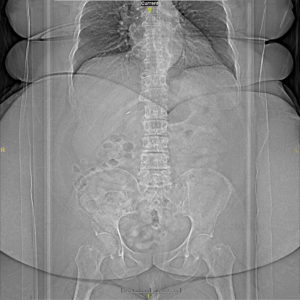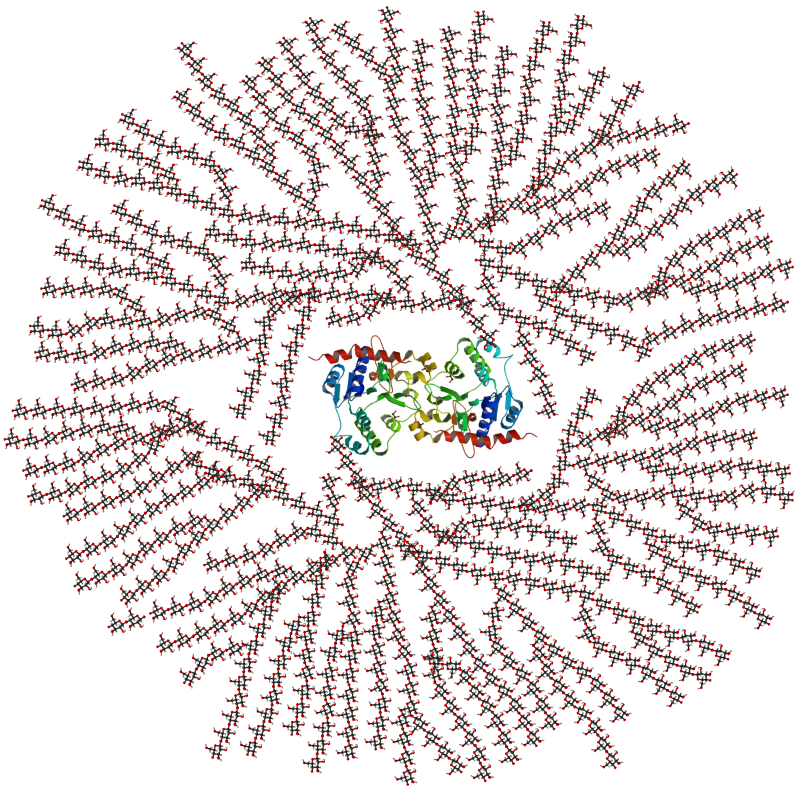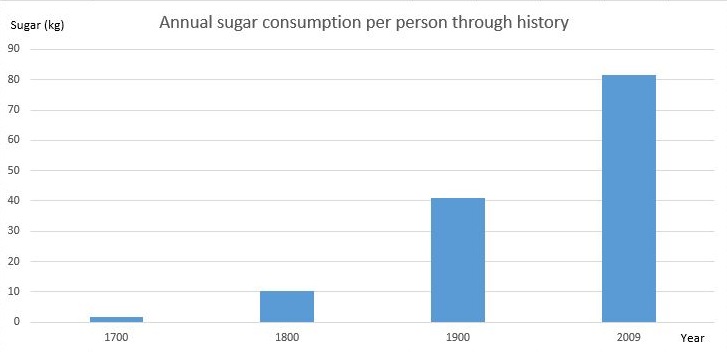I’m tired of all this nonsense about beauty being only skin-deep. That’s deep enough. What do you want, an adorable pancreas? -Jean Kerr
For anyone new to this site, the First Habit is a daily investment in yourself. It’s like sharpening a saw because it helps you become more effective in all you do. It allows you to live the good life, which is built upon the three pillars: health, wealth, and wisdom. Today, I’m going to focus on health: specifically on sugar and why it might be hurting you more than you think.
Recently, I’ve become interested in the physiology of energy metabolism and how diet and exercise affect it. I don’t know, maybe as I’m getting older, I’m starting to think that understanding how my body works just might be a good idea. You know, I want it to last. I feel like the car with 80K miles . . . definitely not new, but likely with lots of good miles left if I take care of it and do the right maintenance.
One thing I’ve focused on is the way the body processes and stores energy (aka the food I’m throwing down my esophagus every day). You might think that a medical education would have made me an expert, but you’d be mistaken. In my 10 years of medical training, I think I only had about a week’s worth of education related to nutrition. You see, doctors are paid to diagnose and fix disease, not prevent it. But I digress.
While I may not have had an extensive education in nutrition and exercise physiology, as a radiologist, I’ve had a front-row seat to see the effects of poor nutrition and a sedentary lifestyle in the bodies of thousands of people. Because think about it. There’s no hiding from me. I have x-ray vision. A CT scan (aka CAT scan) of the abdomen and pelvis is a revealing glimpse into the state of a person’s eating and exercise habits. I see the good, the bad, and the ugly of your muscles, organs, vessels, and yes, fat.

CT “scanogram” of the abdomen. A tiny person hiding inside a large body.
Biscuit-osis
Let’s be clear, when I say ‘fat,’ I’m not using the word to label someone’s body shape, I’m using it to describe the tissue type in the body known also as ‘adipose.’ There are two types: the fat you see, and the fat you don’t see.
And one thing that I’m noticing more and more is the amount of fat many people have deposited around the organs of the abdomen. We call this ‘visceral’ (deep) fat. Research is showing that this kind of fat is associated with a significant increase in health complications.

Yum, biscuits!
And here’s the scary thing, it’s not just fat around the organs. In more and more people, I’m seeing fat buildup within the organs–specifically the liver. Using fancy medical terms, it’s called hepatic steatosis (hepatic = liver, steat = fat, and osis = excess). An old southern doc I work with affectionately calls it “biscuit-osis,” you know, like biscuit overload.
Let’s pause to quickly review the physiology of how this happens:
Processing fat is a key job for the liver. As you eat, the liver acts as a short-term battery storage for energy, specifically glucose. When you eat sugars and carbs, they are broken down into glucose, which is the energy molecule that all your cells use. The liver turns the glucose into glycogen, which is like a storage of glucose.

By Mikael Häggström. Schematic two-dimensional cross-sectional view of glycogen: A core protein of glycogenin is surrounded by branches of glucose units. The entire globular granule may contain around 30,000 glucose units.
Once the liver is topped off with glycogen (it can only hold about 24-36 hours worth), it starts turning the glucose into fatty acids for long-term storage as body fat (you see where this is going). These fatty acids and cholesterol units are built into little fatty ‘packets’ and are then delivered around the body through the blood.
When this process of converting excess carbs to fat has gone on for a prolonged period, all of this extra fat can sometimes lead the liver itself to get fat–i.e. hepatic steatosis. The liver cells accumulate excess fat instead of sending it off to fat cells.
Your Hepatic Delicacy
For you foodies out there, this may sound suspiciously familiar. Foie gras you may know is French for “fatty liver.” It’s a luxury food product which consists of the liver of a duck or goose that has been fattened by force-feeding it carbs (usually corn) with a feeding tube, a process known as gavage.

A goose being force-fed. Don’t let this be you!
Diabetes Epidemic
According to the Centers for Disease Control and Prevention, one-third of Americans will be diabetic by 2050.
When sugar/carb overloading has gone on for years, all kinds of bad things start to happen. This is what we label diabetes, but maybe it should be called sugar toxicity syndrome because that is more descriptive of what it actually is. Our modern diet of high sugar content (short sugars like sucrose as well as longer sugars or “carbs”) is wreaking havoc with the liver metabolism.
Sugar becomes toxic to the body because the body has worn out the sugar-regulating feedback loop and overloaded the storage systems. More specifically the pancreas, after years in overdrive, can’t keep up with demand for insulin (which triggers absorption of blood sugar). At the same time, the body cells become “insensitive” to insulin because of the incessant high levels. And finally, the liver function fails due to all the internal build-up of fat.
Maybe It’s the Sugar That’s Making You Fat
For the last 50 years, fatty foods were accused of being the main problem. Low-fat diets became a major marketing push. Fat and cholesterol were in the crosshairs of public health campaigns. There was some face-value logic to it . . . your eat fat, you get fat.
Yet, it’s now decades later and obesity rates are still rising. In the last few years, there has been a lot of research and investigation into the role sugar (i.e. table sugar, high fructose corn syrup, honey, and other “carbs”) may be playing in the problem. While the science is not yet conclusive, I’m starting to think there is a lot of truth to it. Remember, sugar gets processed directly into fat when you eat more than the body requires for your activity level. In fact, studies show it’s like a skill that your liver gets better and better at if you continue to take in an oversupply. The sugar-to-fat pathway gets very efficient. It’s called de novo lipogenesis (DNL), but this is not a skill you should be proud of.
Sure, excess calories from any source are a problem. At the most basic level, a calorie is a calorie, and if you take in more calories than you burn, you will store it as fat. But the problem within the problem is that sugars and simple carbs ramp up your insulin levels (see “glycemic index“). When insulin is high, it signals other cell processes to be “on.” The problem is that you don’t want the system “on” all the time. There are other reverse reactions in the cell that need time to “clean up” and break down waste products. Simple sugars keep the engine running at high rpms, and as you might expect, the engine wears out sooner from the constant revving.
It’s not all your fault. It’s the work of many many years of concerted effort by the sugar trade industry and massive sugar marketing. Plus, it tastes so good.
Sugar permeates our culture. Think about it, most of the American celebrations revolve around sugary delights: Valentines chocolate, Easter eggs and peeps (on second thought, does anyone actually like peeps?), Halloween candy, Thanksgiving pies, and Christmas gingerbread and candy canes.

Sugar consumption on average by approximate year. How can this not be related to obesity and diabetes?
An occasional holiday treat would be fine, but it’s not just holidays. Added sugar has found its way into every meal. The problem starts in childhood. Pancakes and syrup or sweetened cereal for breakfast. Jam sandwiches, juice boxes, fruit snacks, soda, and cookies for lunch. Fruit leather or a chocolate chip granola bar for a snack. Spaghetti with sweetened tomato sauce and white bread for dinner.
It’s not just that this is a high-calorie diet, it’s composition of calories is highly concentrated. It’s a sugar and carbohydrate tsunami–every day, all day. The probable result of this cultural sugar craze is a diabetes (and metabolic syndrome) epidemic, which sadly more and more includes children.
A Change in Mindset
So, sugar is likely a bigger problem than we’ve realized. Like I said, I’m not the world expert, and I’m no “low carb” fanatic. But the evidence against sugar is mounting and it fits with all I know about how the body functions. It’s like a civil case compared to a criminal case. I don’t have to be convinced “beyond a reasonable doubt,” I’m just looking for a “preponderance of evidence.” It’s enough to cause me to take action, since last time I checked I’ve only got one body and a trade-in isn’t an option.
So what should you do? Panic? Do something drastic? Swear off sweets forever? Well, I guess you could try, but I don’t think you’d be successful.
No, a slowly created problem needs a slowly implemented solution. Baby steps, incremental progress, and sustainable change–that’s what wins in the end. You’d be surprised how much you can change slowly over a year.
Here are a few things I’ve started doing, and you might consider:
- Pay attention to how much added sugar you (and your children) are eating. Read the ingredients list on your food. Look for all the names including high fructose corn syrup, molasses, cane sugar, corn sweetener, raw sugar, syrup, honey, or fruit juice concentrates. You may be surprised to see sugar listed as the #2 ingredient in many products. Just paying attention will start to affect your decisions. If you decide to do only one thing, cut out sugary drinks (includes soda of course, but also fruit juice).
- Eat more whole food (and reduce processed food). Eat things that people 5000 years ago would recognize as food. I’m eating more eggs and protein for breakfast and salads with chicken for lunch. Dinner is trickier, but we’re working on new menus that reduce processed food and carb-dominance. Slow, steady changes make a difference.
- Incorporate intermittent fasting into your weekly routine (more on this later). It’s like a biological reset for your liver and metabolism. You know how a “reboot” of your computer fixes many issues? Well, fasting can do some similar things for your body. It’s like clearing the pantry and starting over. It’s like depleting the battery and readying it for a fresh charge. It allows the liver to clear the glycogen stores, and it gives the pancreas a rest and improves your insulin sensitivity.
- Incorporate some high-intensity interval training into your exercise. Do something that really pushes you. You know, like dripping-sweat hard. The high intensity triggers changes in your cells (mitochondria) that help you use energy more efficiently, and a slow jog just won’t get you there.
- Measure your health KPIs (hint: your weight is not the best indicator of health). Write these down and then recheck them once a quarter to track your progress.
Bottom line: The standard American diet is overloaded with sugars (both obvious and not so obvious), and the role of sugar and excess carbs in causing obesity and diabetes is becoming more clear. Constant sugar input can wear out the pancreas, numb the body cells to sugar levels, and overload the liver with fat. In blunt terms, this leads to a crappy existence and a slow, painful, costly decline into an early demise. You may think this doesn’t apply to you, but likely it does. It’s a spectrum of disease, and Americans are sliding toward the wrong end.

It’s hard to resist the gravitational pull toward obesity and diabetes
The good news is that in most cases, the body can repair, regenerate, and restore itself to a healthy state. But you have to first recognize the problem, and then and take action. Don’t depend solely on a doctor to optimize your health. Check your own health indicators.
Do you have excess abdominal fat, high blood pressure, and/or elevated fasting blood glucose? These are warning signs. Decide today to make some changes, and leave the carb gavage and the foie gras to the French.
Learn more:
There’s A War On Sugar. Is It Justified? An entertaining and informative discussion on the Freakonomics podcast.
The Case Against Sugar An investigative journalist digs into the history and politics of sugar industry over the last several decades. [Surprise! Powerful interest groups have been doing their best to manipulate the public message about sugar.]
The Obesity Code. A Canadian physician Dr. Jason Fung sets out an original, robust theory of obesity that provides startling insights into proper nutrition.


I liked the post.
Most Americans could benefit by making dietary changes. We are all too willing to blame genetics or environment for things we could change with diet and exercise.
My only beef with the article is a pet peeve of mine. The term “carb” has been misused and vilified for a long time now.
We all get more than enough protein in America. If we eat fewer carbs then we must eat more fat? There are only three macronutrients.
We actually need to eat MORE CARBS – just not processed or highly refined ones like white bread, sugar, cookies, etc. We need more complex carbohydrates – namely good old fashioned fruits and vegetables.
Yes, I can see your point. It’s all in decisions about the ratios of the three macros. What is ideal will be different for different needs and goals. There is facinating research going on in the realm of the ketogenic diet (less than 50 carbs per day). Yes, this does mean compensating with fats. I’m not saying that is what I recommend, but it mimics the fasting state and has has positive implications for epilepsy and possibly cancer. Likely more on this to come.